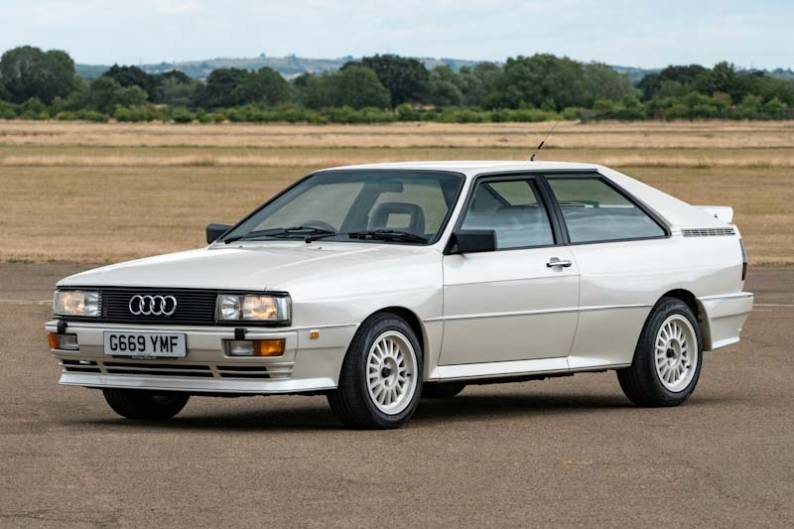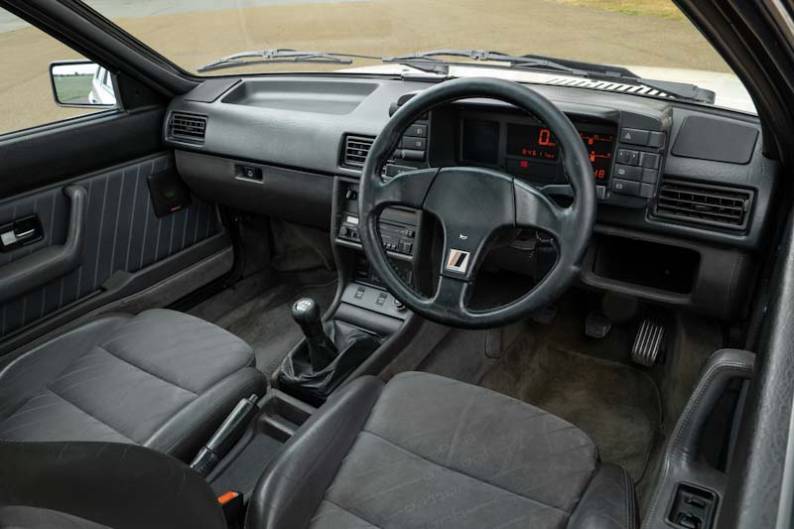
Cheaper than AA or we’ll beat by 20%^
• Roadside cover from £5.49 a month*
• We get to most breakdowns in 60 mins or less
• Our patrols fix 4/5 breakdowns on the spot
*At least 10% of new customers pay this for single-vehicle Roadside (Basic). ^Find the same cover cheaper on theaa.com within 7 days & we'll beat it by 20%. T&Cs here.

BY ANDY ENRIGHT
Introduction
At the turn of the eighties, Audi was just another German manufacturer turning out worthy, but slightly dull family cars. The Quattro turned Audi around, giving it an enviable reputation for progressive thinking and high quality. It also revolutionised world rallying and rewrote the rulebooks on how cars should stick to the road. Alongside the Mini, the Audi Quattro is probably the most significant car of the post-war era. Why? The Quattro was the car that took four-wheel drive out of off-roaders and put it in a sports coupe.
Automotive historians may well note that Audi weren't the first to do this, being beaten to the punch some years earlier by Jensen's revolutionary FF. The Quattro capitalised on its appeal by dominating world rallying, filtering its technology down into more prosaic cars in the Audi range and spawning countless copycat editions. It's only thanks to the Audi Quattro that we now have the Subaru Impreza, Mitsubishi Lancer Evo, Nissan Skyline, Porsche 911 turbo and Lamborghini Diablo - all equipped with four-wheel drive. 'Legend' is a hackneyed expression, but if any car deserves this title, it's the Audi Quattro.
Models
Models Covered:
QUATTRO, QUATTRO 20V
History
The Geneva motor show in 1980 was the arena for the launch of several impressive cars, all of which were completely steamrollered by the column inches devoted to Audi's sensational Quattro. The Ur (German for 'original') Quattro had a 2144cc 5-cylinder turbocharged engine that generated 200bhp and was able to sprint to 60mph in 7 seconds. Using a relatively simple system of electromagnetic differentials to deploy the drive to all four wheels, the car went on sale in the UK the following year, available only in left hand drive.
In late 1982, right-hand drive Quattros began to appear, and the following year the early twin-headlamps were phased out in favour of sleeker single units. In a move that was mirrored with the Audi TT in 1999, Audi also made small adjustments to the rear suspension to make the back of the car slightly less of a handful. 1984 saw the introduction of the unpopular talking digital dashboard, Bosch ABS brakes, uprated springs and dampers and more purposeful 15-inch alloys.
A comprehensive revision to the car took place in 1985. The original lines, as styled by Englishman Martin Smith, were facelifted slightly, and the engine was expanded to 2226cc with a smaller electronically controlled turbocharger keeping the power the same but virtually eliminating turbo lag. The talking dash was finally muted, but the key change to the car, however, was lurking well beneath the now-familiar boxy lines. A Torsen (torque sensing) differential was fitted, which acted in a far more 'intelligent' manner than the old diff, which merely directed half the drive to the front wheels and half to the rears. With the Torsen centre diff, the Quattro could now direct up to 75% of the drive to the pair of wheels most able to deploy it cleanly. This massively increased the already prodigious levels of grip and preserved Audi's superiority over a host of me-too copycats from rival manufacturers.
In 1989, with the Quattro nearing the end of its production run, Audi produced a car that enthusiasts have clamoured after ever since. The Quattro 20v had, as it's name suggests, a twenty-valve cylinder head, boosting power to 220bhp. The interior was notably more luxurious than in previous models and it remains the definitive mainstream Quattro model, lasting as it did until late 1990.
'Mainstream' is a term chosen deliberately, as in 1984, Audi released a series of 200 Sport Quattro specials. At £51,000 apiece, the Sport Quattro was, and still is, a very serious undertaking. Boasting 306bhp and with a wheelbase a foot shorter than the regular Quattro upon which it was based, the Sport Quattro was built to combat the Group B rally threat from the Peugeot 205T16 and the Lancia Delta S4. Only around 20 ever made their way to these shores, and they don't come up for resale too often.
What You Get
With an Audi Quattro, what you're getting is the original, and, many would argue, the best. The years haven't taken the edge off the performance - in fact a Quattro 20v has been measured as quicker than a modern Nissan Skyline GT-R R34 around a wet handling circuit - but the view from inside still feels resolutely eighties, with the boxy dashboards and skinny pillars reminding you of the car's vintage.
What's perhaps forgotten about the Quattro is its practicality. Despite competing for sales with the Lotus Esprit and Porsche 911SC, the Quattro is far less demanding to live with, boasting a fair size boot (despite the coupe shape it isn't a hatchback), good head and legroom in the rear and a cabin that's airy with good all-round visibility. It's this lack of intimidation that helps make the Quattro so easy to drive quickly.
Equipment levels are relatively high (for a German vehicle at least), although the later 20-valve cars were considerably better specified. Standard equipment included ABS, leather trimmed seats, electric windows, central locking, sunroof and remote control door mirrors. If you're used to CD auto-changers, air conditioning, stability control and sat nav, you may have to wind the mental clock back a few years!
What You Pay
Please fill in the form here for an exact up-to-date information.
What to Look For
Quattro Rule Number One. If the car doesn't have an approved alarm/immobiliser, fit one ASAP. These cars are notoriously easy to break into and steal and there have been many tales of these cars disappearing into the night. Rule Number Two would be to check the odometer reading to see whether a cam belt change is forthcoming. These occur every 80,000 miles, although a diligent owner may not be prepared to push his or her luck. Engine rebuilds occur at about 120,000 miles for ten valve cars and double that for twenty-valve models, and will cost in the region of £3,000 for a 10v and £4,000 for a 20v. At the same time as a rebuild, most garages will recommend a turbo overhaul at £400 a pop.
Bodywork is usually good, but inspect early left hand drive cars carefully, as the rustproofing treatments were less than extensive. The interiors are fairly hardy, with the Jacquard seat trim being particularly tough. Electronic dashboards have been known to go on the blink and driver's seat frame and mountings aren't the toughest. Gear knobs and steering wheels may well have been well-worn or replaced. Headlamp lenses go brown (an Mot fail) after about ten years.
Watch for kerbed wheels or heavily modified cars, both of which indicate less-than scrupulous ownership. If you're in the market for a Sport Quattro, make sure what you're looking at is the genuine article. Companies such as Dialynx have specialised in making excellent replica Sport Quattros from standard cars and you should always bring an expert.
Replacement Parts
(approx based on a 1989 20-valve Quattro) A clutch assembly kit will be around £275, whilst the headlamps will be around £130. A decent set of competition brake pads will be around £70 a pair, and a windscreen around £125. A minor prang will result in major bills, with a front bumper costing almost £1200 and a front wing around £300. Insurance is Group 20, although you may get a good deal on specialist classic insurance.
On the Road
The years have been good to the Quattro driving experience. The car feels nimble and bulletproof, despite its obvious size. Firing up the five-cylinder engine you'll hear a husky burble that barks when you rev it hard, the tappets ticking away when cold. The gearbox is slightly notchy as you slot the stubby leather-clad lever into first, but the clutch should feel light and progressive. As you pull away, you may notice a slight clicking from the steering as the power steering brushes the indicator cancelling detents, but this is nothing unusual. The first time you floor the throttle you'll understand the appeal of the Audi Quattro.
Wet or dry, the nose will rise slightly, the turbocharger will spool up and the big Quattro just grips and goes. The nose runs slightly wide at the limit, but the front-end bite is so good with that heavy engine slung well forward, that you never feel as if you're teetering on the brink of a humbling insurance claim. It will perform this 'push' of the front end if you enter a corner with not enough revs on the board, but instead of backing off the throttle to tuck the nose in, just wait for the revs to rise and the cornering attitude becomes beautifully balanced. It's counter-intuitive if you're used to a front-wheel drive car, but you'll get used to it. Have fun by all means, but please try not to reduce the world population of Quattros. They're on the endangered list.
Getting used to the power of the Quattro, especially the 20-valve cars is an enjoyable way to spend a weekend. Able to reach 60mph in 6.2 seconds on the way to a top speed of 143mph, you'd need to make a pretty significant investment to buy something that would put distance between itself and the Audi.
Overall
A legend. The Quattro does everything you expect it to with a depth of character unmatched by more contemporary offerings. Buy with caution and remember that a Quattro isn't really the weapon of choice if you're after budget performance as running costs are high.









